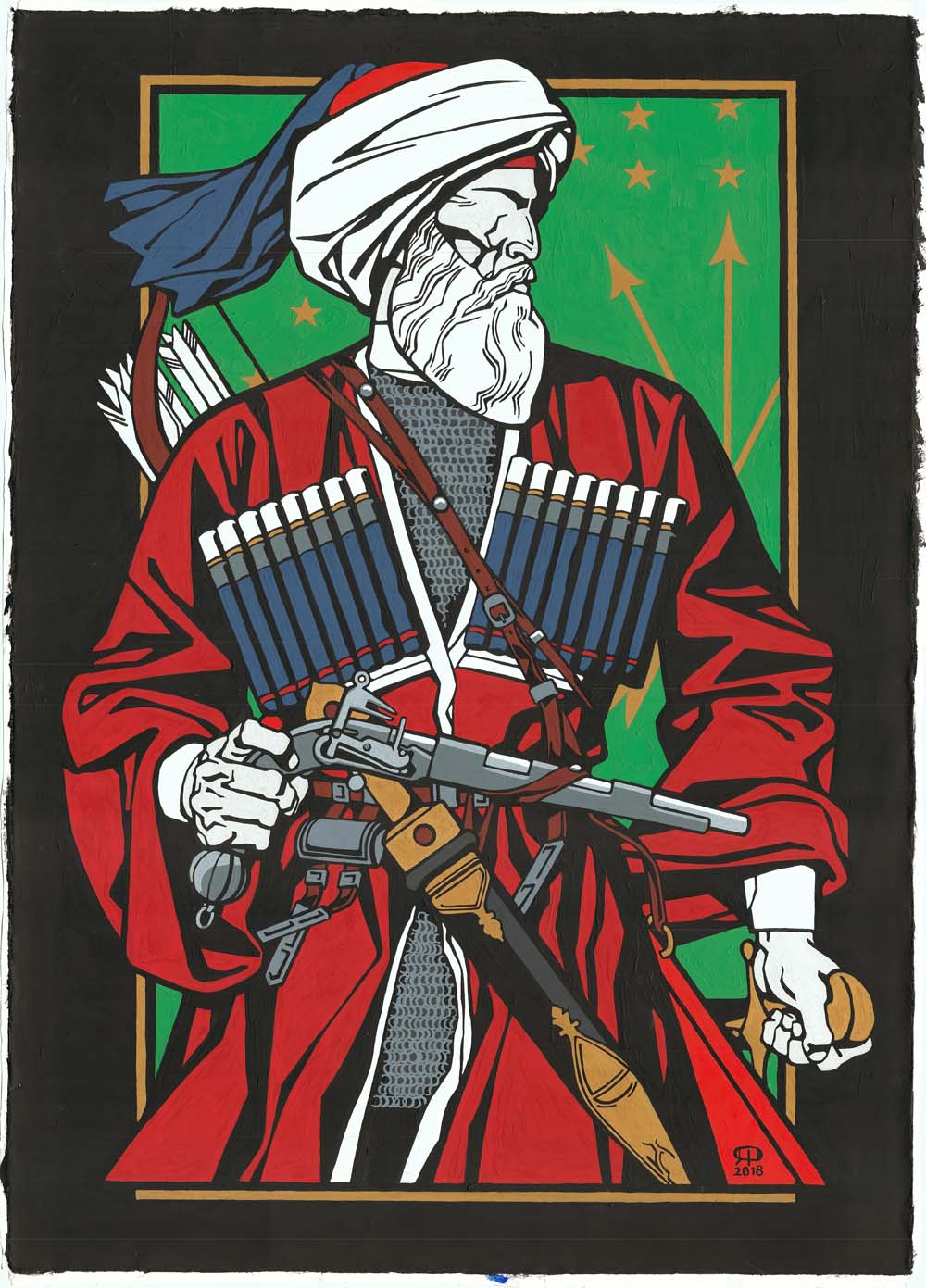

Kizbech Tughuzhuqo
From a very young age he was distinguished by a striking fearlessness, combined with a character of harsh and rude. His very appearance, his huge height, loud voice, impertinent and rude grip, it seemed, created in order to have an irresistible effect on the people.
Kizbech Tughuzhuqo takes a special place among the ranks of heroes of the Caucasian War. No one knew how to keep the Cossack border troops in constant tension like he did. The legendary leader of the Adyghian in the struggle of Cherkessia for independence was born in the village of Beannash in 1777.
His military activity in Cherkessia fell on 1810-1839 years. For his numerous victories in battles he was popularly nicknamed the "lion of cherkessians". In 1796 he took part in the Battle of Byzik, where he almost lost his head, and was left with a deep scar. There were battles when Kizbech was victorious over the tsar's troops although his numbers were significantly lower: for example, when leading 700 shapsugian horsemen he dispersed 14 thousandth tsar's detachment. Often Tughuzhuqo showed personal courage and heroism, as in 1837, when he alone rushed to the guard of the Nikolaev fort, capturing a soldier and taking 9 rifles with him.
Kizbech in his attacks - "raids" used his own strategic techniques, such as false retreat, which the Cossacks called "the lure technique". When the Cossacks, pursuing the highlanders, broke away from their own, "lion of cherkessians" began to attack them. Or another trick - stretching the riders in the "rope". The rider pretended to escape his pursuers, stretched them into a line, then abruptly stopped the horse, turned back and struck the pursued opponents with his sword, not giving them a chance to come to their senses. "A Circassian who is a runaway is still far from a defeated warrior."
As a warrior, Tughuzhuqo was highly respected among his opponents. Tsarist generals entered into negotiations with him and repeatedly offered to transfer to the service of the Russian Empire. But the "lion of the Circassians" treated such offers with contempt.
The Adyghe folklore preserved the legends describing him as an example of the soldier "affecting with fearlessness" and harshness. Neither the deaths of his sons, nor numerous wounds, nor old age weaned Kazbich from his favorite trade - war. In his old age, he went to Mecca, but the sacred title of hajji did not calm the stubborn heart of a harsh rider in him; all his life, he remained a tough Shapsug of the old type. And he died, though in extreme old age, but from the wounds received at the assault of the Veliaminov fort on February 29, 1840.
Kizbech Tughuzhuqo takes a special place among the ranks of heroes of the Caucasian War. No one knew how to keep the Cossack border troops in constant tension like he did. The legendary leader of the Adyghian in the struggle of Cherkessia for independence was born in the village of Beannash in 1777.
His military activity in Cherkessia fell on 1810-1839 years. For his numerous victories in battles he was popularly nicknamed the "lion of cherkessians". In 1796 he took part in the Battle of Byzik, where he almost lost his head, and was left with a deep scar. There were battles when Kizbech was victorious over the tsar's troops although his numbers were significantly lower: for example, when leading 700 shapsugian horsemen he dispersed 14 thousandth tsar's detachment. Often Tughuzhuqo showed personal courage and heroism, as in 1837, when he alone rushed to the guard of the Nikolaev fort, capturing a soldier and taking 9 rifles with him.
Kizbech in his attacks - "raids" used his own strategic techniques, such as false retreat, which the Cossacks called "the lure technique". When the Cossacks, pursuing the highlanders, broke away from their own, "lion of cherkessians" began to attack them. Or another trick - stretching the riders in the "rope". The rider pretended to escape his pursuers, stretched them into a line, then abruptly stopped the horse, turned back and struck the pursued opponents with his sword, not giving them a chance to come to their senses. "A Circassian who is a runaway is still far from a defeated warrior."
As a warrior, Tughuzhuqo was highly respected among his opponents. Tsarist generals entered into negotiations with him and repeatedly offered to transfer to the service of the Russian Empire. But the "lion of the Circassians" treated such offers with contempt.
The Adyghe folklore preserved the legends describing him as an example of the soldier "affecting with fearlessness" and harshness. Neither the deaths of his sons, nor numerous wounds, nor old age weaned Kazbich from his favorite trade - war. In his old age, he went to Mecca, but the sacred title of hajji did not calm the stubborn heart of a harsh rider in him; all his life, he remained a tough Shapsug of the old type. And he died, though in extreme old age, but from the wounds received at the assault of the Veliaminov fort on February 29, 1840.

"Tughuzhuqo Kizbech" 2022. Lithography. 50х31
"He is a man of stature and bogatyr strength.
On his harsh, big-nosed face lies complete serenity,
and in his movements one feels strength and confidence."
On his harsh, big-nosed face lies complete serenity,
and in his movements one feels strength and confidence."
En
/


